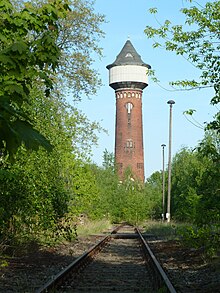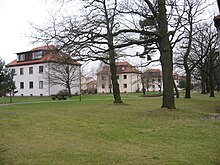Elstal
|
Elstal
Wustermark municipality
Coordinates: 52 ° 32 ′ 24 ″ N , 12 ° 59 ′ 24 ″ E
|
|
|---|---|
| Height : | 47 m |
| Residents : | 4455 (March 1, 2020) |
| Incorporation : | December 31, 2002 |
| Postal code : | 14641 |
| Area code : | 033234 |
With 4,455 inhabitants (as of March 2020), Elstal is the largest district of the Havelland municipality of Wustermark , north of Potsdam and west of Berlin .
history
Origin until 1945
At the beginning of the 20th century, the Wustermark marshalling yard was laid out in the open . In 1909 the station went into operation. It became one of the largest marshalling yards in Germany. The construction of apartments for the railway workers was delayed by the outbreak of the First World War . On November 1, 1918, parts of the districts of Dyrotz, Hoppenrade, Buchow-Karpzow and Ferbitz formed the Elstal manor district with an area of around 184 hectares, whereupon the Elstal railway settlement emerged in the following years. In 1920 the first apartments could be moved into. In the same year a school was built in the settlement. The Wustermark depot next to the marshalling yard was also built in the same period. The Wustermark depot included two ring locomotive sheds, two turntables, four coaling plants and a 56 meter high water tower, which became the town's landmark.
On September 30, 1928, the Elstal manor district was dissolved and an independent municipality of Elstal was founded. An area of 40 hectares was also assigned to it from the Dyrotz estate. In 1930, the young municipality, which at that time consisted of 86 blocks with a total of 376 households, received a market square with a larger business complex that housed a butcher, a bakery and other shops. In 1936 a Protestant church was built on the market square.
In 1936 the XI. Summer Olympics take place. For the athletes, a residential complex was built as an Olympic village from 1934 in Dallgow on the border with Elstal . After the Olympic Games, the Olympic Village was used for military purposes, and the National Socialists had further barracks and an air base built.
1945 until today
From 1945 the heavily bombed station and the settlement were rebuilt, the Olympic village served as the home of the SASK Elstal . The Wustermark marshalling yard was renamed the Wustermark marshalling yard in 1963 . The passenger stop belonging to the station has been called Elstal since 1996 .
In 1992 the community set up the so-called DEMEX-Park , a 350,000 m² industrial area on which the 10,300 m² shopping village Designer Outlet Berlin was opened in 2009 . By the 6th municipal reorganization law in October 1996, the Olympic village, which was previously on the territory of the neighboring municipality of Dallgow, was added to Elstal.
In 1997 the Theological Seminary of the Federation of Evangelical Free Churches (today: Elstal Theological University ) moved its headquarters from Hamburg-Horn to Elstal. In addition to the university, other educational institutions as well as the administrative headquarters of the Federation of Evangelical Free Churches and the European Baptist Mission Society are located on the premises of the education center . The Oncken archive , which is also located on the premises of the education center, houses extensive collections on the history of Baptism and the free churches as well as the estate of the Wuppertal sociology professor Peter Dienel . He is considered to be the inventor of the public participation process planning cell .
On December 31, 2002, the Elstal community was incorporated into Wustermark. Part of the aforementioned marshalling yard was taken over by the Rail & Logistik Center Wustermark (RLCW) in 2008 . An annual railway festival has been held at the station since 2002 .
Local division
- Railway settlement
- Eulenspiegel settlement
- Heather
- Karl-Marx-Strasse
- Pine settlement
- Cherry stone settlement
- Olympic Village
- Radelandberg
- Scharnhorstsiedlung
- Steel house settlement
- Stone house settlement
- Thälmannplatz
Attractions
One of the sights is the marshalling yard , which has been a listed building since 1993. The Olympic Village built in 1936 is of particular interest . Guided tours are offered here.
On the southern outskirts there is a 36-hectare show enclosure; it was opened in 2006 by the Sielmann Foundation as part of the Sielmanns Naturlandschaft Döberitzer Heide project . The total size of the Sielmanns natural landscape is approx. 3,600 hectares.
In May 2014, Karls Erlebnis-Dorf opened in Elstal near the B 5 . In addition to various attractions, there is also the farmer's market and Karl's court kitchen. There is also direct access to the Sielmanns Natural Landscapes show enclosure .
traffic
Elstal has a train stop on the Berlin – Lehrte railway line , served by the RB 13 and RE 4 . It is located at the Wustermark marshalling yard .
Web links
- Wustermark municipal office population
- Historia Elstal: Chronicle
- Historia Elstal: Local breakdown
- Contribution to the RBB program Landschleicher on September 14, 2008
Individual evidence
- ↑ About Wustermark: Population. Wustermark community, accessed on March 17, 2020.

